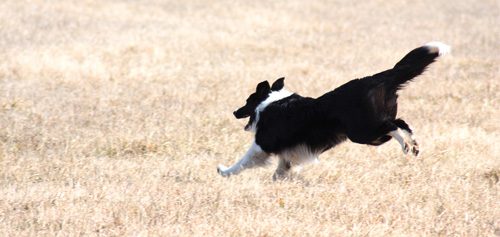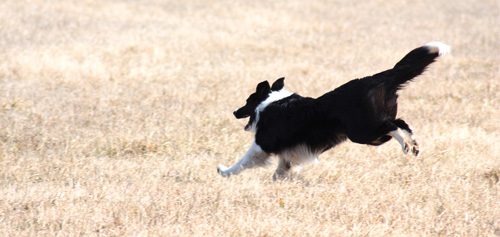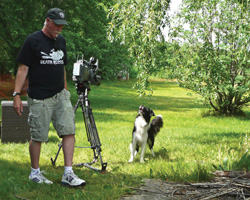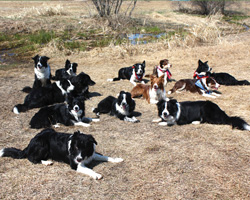

Love is Blind
A blind Border Collie challenges preconceptions of (so-called) disabilities.
When a little boy named Leo came home from school, he couldn’t stop talking about the wonderful Border Collie that had visited his class that day. Despite being blind, Riddle could run and play and even fetch. Leo formed an immediate bond with Riddle, and wrapped his arms around the dog’s neck for the class photo. The Collie’s accomplishments held special meaning for the boy, because, like Riddle, Leo is also blind.
Riddle’s story is not one of disability. Lack of sight hasn’t slowed Riddle down at all: he races his canine companions through fields and can catch a ball—or a Frisbee—like any other dog.
“That’s the thing,” says Sally Hull of Hull’s Haven Border Collie Rescue in Teulon, Manitoba, and Riddle’s owner. “He doesn’t know he has any challenges. It’s why we’re so blown away by it. Once we got him, we treated him like any other dog; no special privileges.”

Hull first became involved with rescuing dogs two-and-a half years ago. She had already acquired her first Border Collie, Frodo, and fallen in love with the breed. With Frodo in flyball, she met some breeders and other people involved with dog rescue.
“My inspiration was my friend Shahna, who died last year of breast cancer,” Hull explains. “She had told me about the dogs in the [US] and the gassing pounds. I started doing fundraising for her. I totally believed in her cause. I thought maybe, just maybe, I could do this.”
While Hull was still in Winnipeg, she was contacted by a woman who said she had a blind six-month-old Border Collie puppy.
“She was a single mom and didn’t have the time to spend. She asked if I could help. I said I would do an assessment and take a look.”
The pup arrived in the back seat of a car. When Hull opened the car door, she was greeted by a cowering, snarling ten-month-old dog.
“He wasn’t going anywhere,” says Hull. When the dog refused to exit the vehicle, she thought, “Oh my God, what did I get myself into?”
She tried forcing the dog out of the car but he wouldn’t move. Hull hooked a leash onto his harness and dragged him out, where he just lay by the side of the road.
“By the time I got him into his crate, I left him for three hours to decompress. I would chat with him so he could hear my voice. For the first few days, around his bone or food, he would show his teeth. He wasn’t bad with the other dogs, but getting him outside meant dragging him out and back. Then, on day three, he walked out on his own, high stepping like a horse, feeling for the stairs. Once he got the hang of it, he was running without hesitation,” she says.

“The dog boggles the mind,” she says.
Riddle, her vet told her, was born without eyes. The vet made her initial visit to Hull’s home to avoid any further trauma to Riddle in those first few days. “I had hoped she would find a viable eye back there. There was nothing there. One eye is almost completely closed; the other eye is pink flesh. She said not to sew it shut as it wasn’t bothering him and his tear ducts worked.”
Hull wasn’t the only one who could easily see that Riddle wasn’t held back by his lack of sight. When Hull and Riddle visited a daycare with another of her dogs, Jack, she let the kids watch the two canines chase a ball. Riddle caught it while Jack just let the ball bounce off of his head. Hull then asked the children which dog was blind. They chose Jack.
“When I said it was Riddle, they were stunned,” she says. “Just because he has a disability, doesn’t make him any less. If he wants something bad enough, nothing stands in his way.”
A typical day for Riddle starts with a long walk with Hull’s 12 other dogs (11 belong to her and her business partners, one is a foster dog). Riddle attends fundraisers and often visits with kids.
“We’re trying to teach him not to launch [jump up]. It’s kind of funny. You can tell he is about to do it. He tilts his head to the side—it’s his Stevie Wonder look—and puts his beak up in the air toward the sky and tilts his head back and forth from side to side and goes from foot to foot, listening. He loves kids so much, he wants to jump on them. We’re working on finessing.”
Hull is in the beginning stages of discussing a working partnership with the Canadian National Institute for the Blind (CNIB).
“We want to promote awareness about people and animals with disabilities. Riddle was going to be killed as useless. But he can do anything other dogs can do. We want to raise awareness for rescue, too.”
Hull says she has never looked back on her decision to bring Riddle into her home, believing he was placed in her path for a reason—to teach people lessons.

She says Riddle has taught her to recognize what she herself is capable of. Hull and her business partners are almost finished building a boarding kennel on her property. Ruff House Boarding and Training Centre will be a huge facility based in her 70-acre parcel, with several large pens where dogs can hang out together, and a 3,200-square-foot training centre and play area. There will be agility equipment and lots of individual attention.
Of course, there will also be a separate building a bit farther away to house rescue dogs and help them prepare for their forever homes.
“Riddle is raising awareness about rescue. When we have raised enough money for the rescue centre, we will build it. We will have a rescue centre, especially for quarantined dogs. It’s all because of Riddle.”
“He has taught us so much. There are some things that are hard to explain. People see him and their first reaction is ‘poor dog.’ It really irritates me. He’s a thriving, happy dog. All who meet him walk away with a big grin. Riddle is full of joy all the time and we feel really blessed.”
Join the newsletter and never miss out on dog content again!
"*" indicates required fields
By clicking the arrow, you agree to our web Terms of Use and Privacy & Cookie Policy. Easy unsubscribe links are provided in every email.